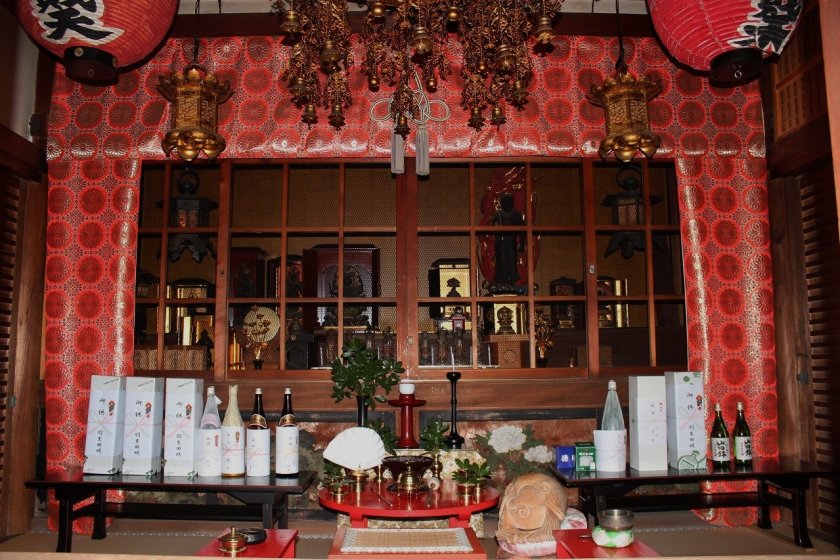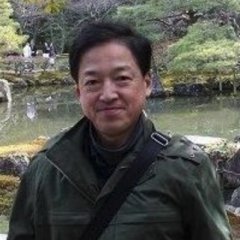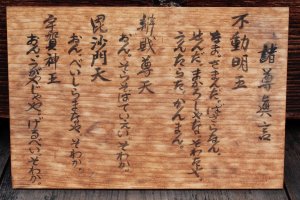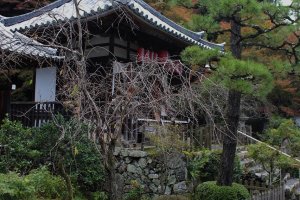(This is the second article to a two part story. For part one, click here.)
"There are some things I want you to lend me. First I need eight large vats of yashioori sake."
What kind of sake is yashioori sake (八塩折之酒)?
Looking at the kanji (Chinese) characters, we can see the first character「八」is similar to its usage in the word 八百屋 (yaoya--green grocer), thus it means ''many'' or ''a lot''. The character for ''salt'' as well as the character for ''fold' are also present. During the yashioori sake production process, salt is pressed from the aging mash, which is then folded over and the process repeated many times.
Ashinadzuchi and Tenadzuchi spent the whole night making the yashioori sake.
They placed the freshly brewed sake in front of Susanoo and he then spoke again:
"Please make eight gates and put a full vat of the alcoholic drink behind each one."
Ashinadzuchi and Tenadzuchi did so.
Suddenly dark clouds filled the skies and the defeaning sound of rain, wind, and thunder attacked. In the middle of the chaos was the monster Yamata-no-Orochi. Susano was hiding himself in a nearby thicket as he watched this nightmare on Earth stick its necks through the eight gates. He then heard gulping; the beast was drinking the sake.
The sake proved effective and soon the monster collapsed into a deep slumber on the grass in its drunken state.
In no time, Susanoo used the legendary sword Ame-no-Ohabari to hack the beast to pieces, separating not only its heads from the necks, but its tails were also cut from the torso.
When cutting off the last tail, the swing of Susanoo's sword was met with a loud clanking sound. Inside the tail there was a mysterious glowing silver sword.
Susanoo took out the sword. The sword was the mythical blade called Kusanagi, or "grass cutter". Susanoo, slayer of Yamata-no-Orochi, removed the comb from his hair. Kushinada-hime returned to her original form.
Susanoo and Kushinada-hime said goodbye to Ashinadzuchi-Tenadzuchi to start their journey as a new couple. They settled down in Suga, Izumo.
An abundance of green spread thoughout the low, gently rolling hills before Susanoo's eyes. The hills were paired with the hazy mountains in the distance where a refreshing breeze blew and gave life to everything around. This would be the perfect place to live, he thought. Taking Kushinada-hime's hand, he recited a tanka poem.
"Yakumo tatsu izumo yaegaki tsumagoi ni yaegaki tsukuru sono yaegaki wo"
The verse summarizes Susanoo's feats and future plans. The backstory reiterates that Yamata-no-Orochi has come for his beautiful wife, but that Susanoo wants to be with Kushinada-hime and protect her. So he builds a palace with mutliple layers of defences. If Kushinada-hime were to imagine that each fence of the fortified mansion is like one of the many clouds in the sky, she could feel that she is protected by heavenly divination.
There are several theories among researchers of the Yamata-no-Orochi legend. One such theory states the monster in the story is symbolic of floods and rampaging rivers. Another idea suggests the creation of Yamata-no-Orochi was inspired by actual, or the fear of, invading soldiers from a distant country. Furthermore, the beast was said to be all powerful because it came from a place of advanced metal technology, where the secrets of bronze creation, replacing iron, were well practiced. All theories are quite interesting.
The once local lore of Yamata-no-Orochi spread all across Japan.
During the mid Kamakura period (1185–1333), there is a reference in a rough description of several temples in Asaba (阿裟縛抄諸寺略記) dating back to the mid 800s.
A long time ago, Kuzuryu, a demon with 9 heads and 9 tails lived on Mt. Togakushi. The demon was trapped in Iwato because of an exorcism by a monk named Gakumon. That demon was considered a good deity because it helped people as a deity of water.
However, there is also the story of Benzaiten. She is the Hindu goddess Sarasvati which came to be incorporated into both Buddhism and Shinto religions in Japan. Since ancient time, Benzaiten has been worshipped as a diety of wealth and good luck. She has attracted many believers and admirers in Japan, where she is humbly referred to as Benten-sama.
The nine dragon-headed water god Kuzuryu and Benzaiten seemed to have fused together. According to Japanese history, there is a large river which it continues to swim across for generations. Put your hands together to pray in front of the statue representing the deity and you will feel the grace of the heavens shine upon you.

































